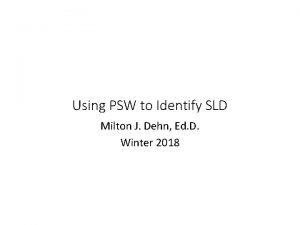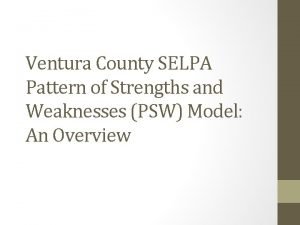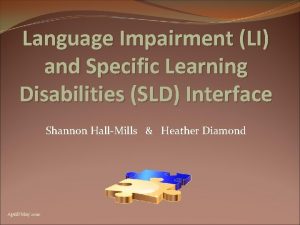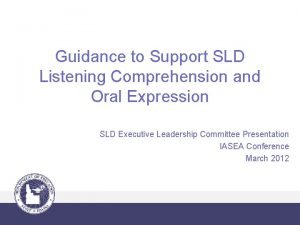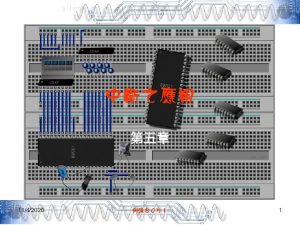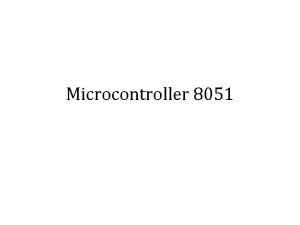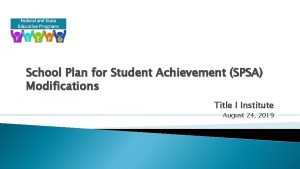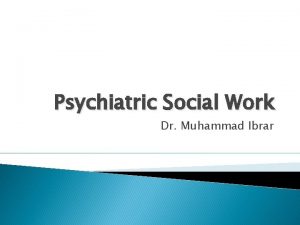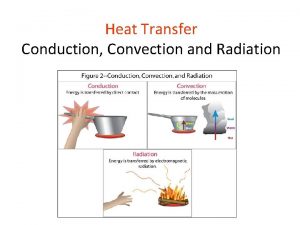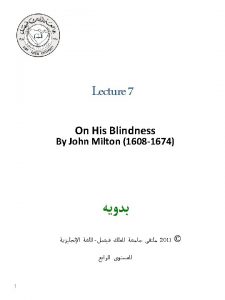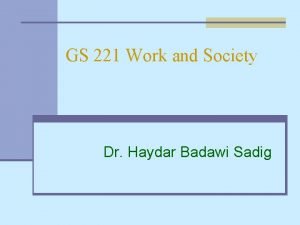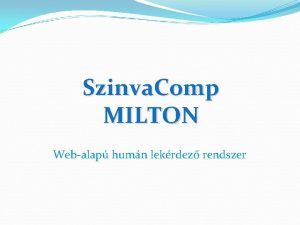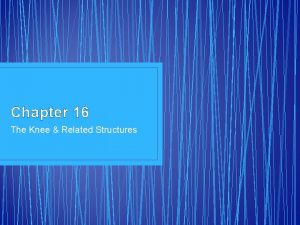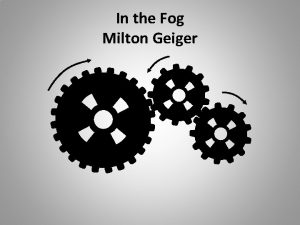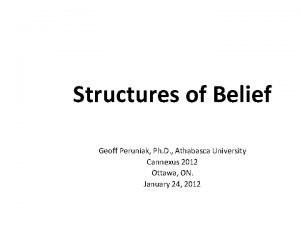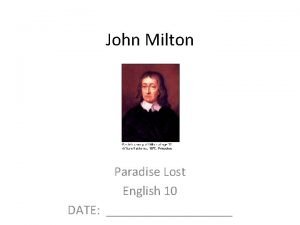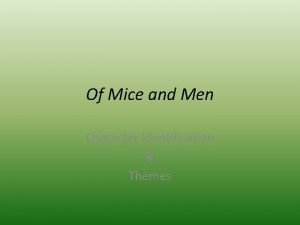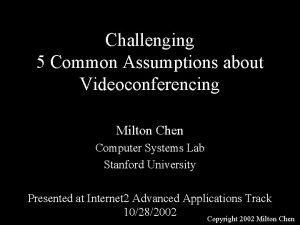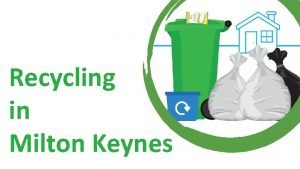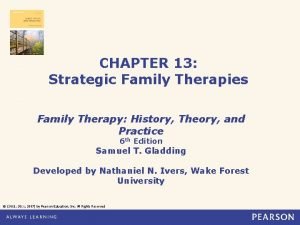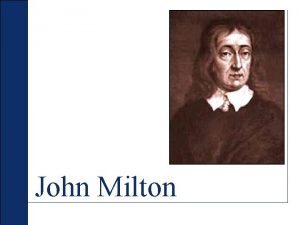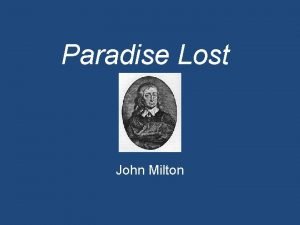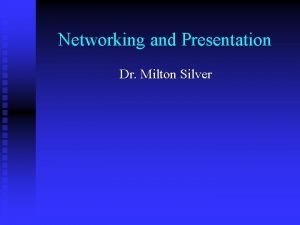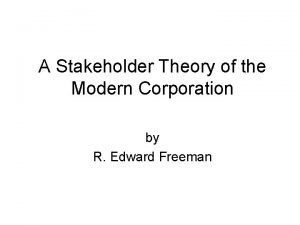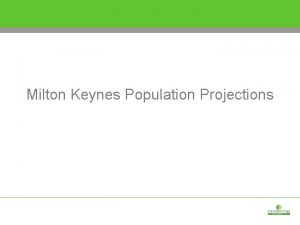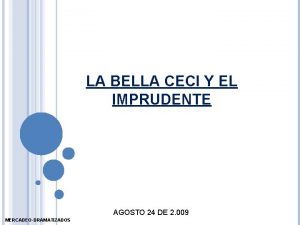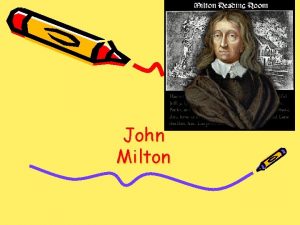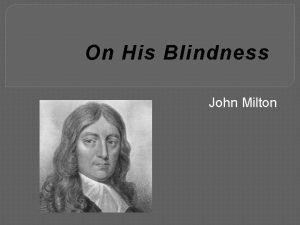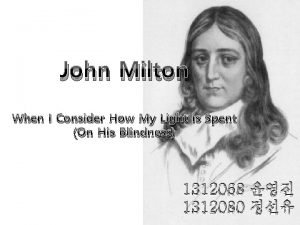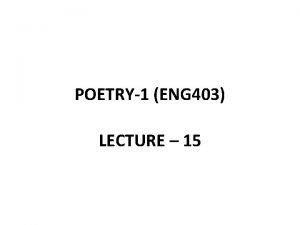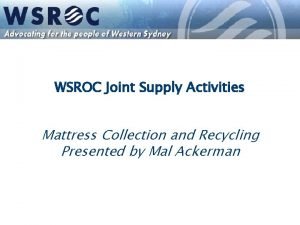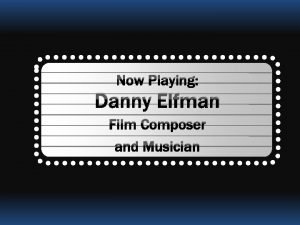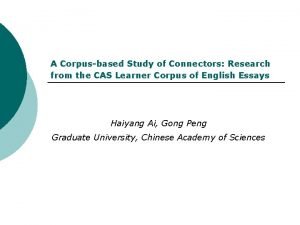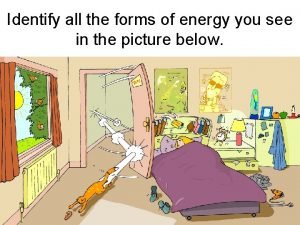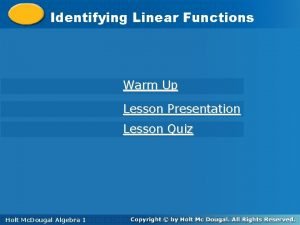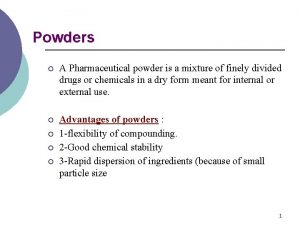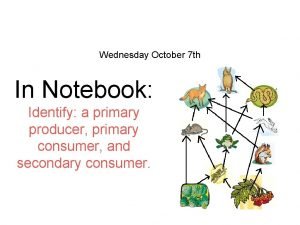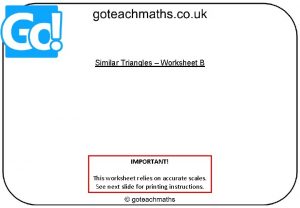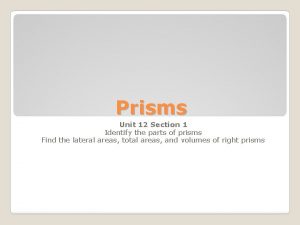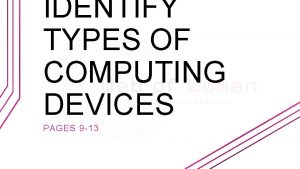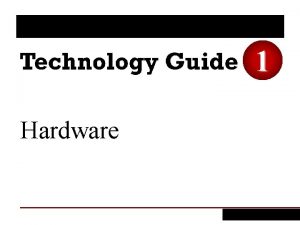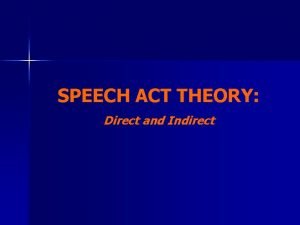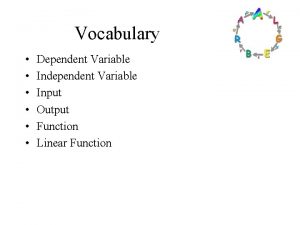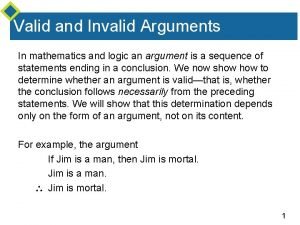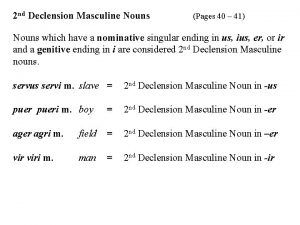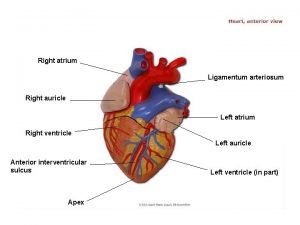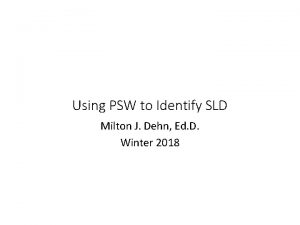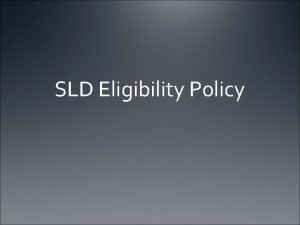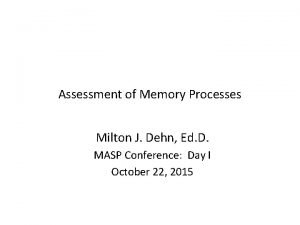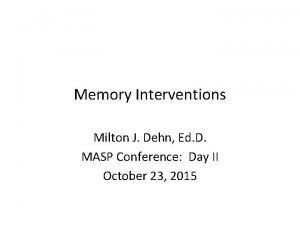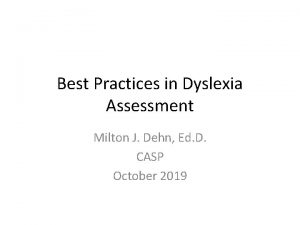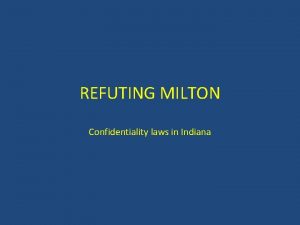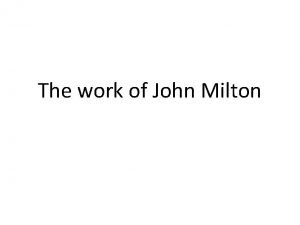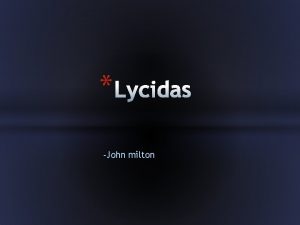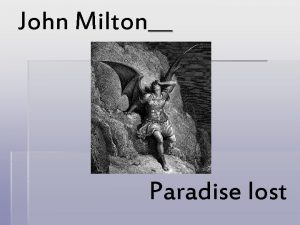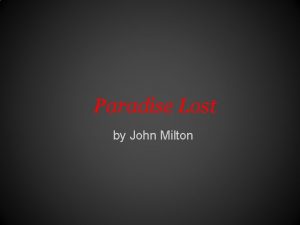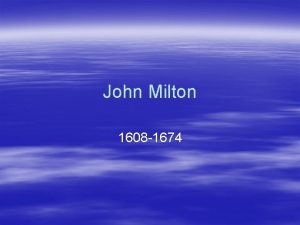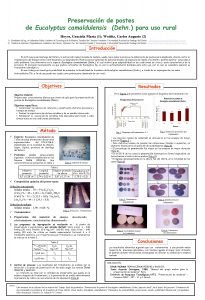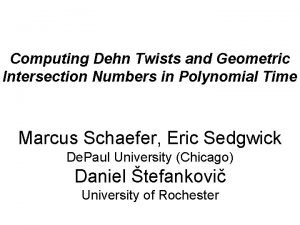Using PSW to Identify SLD Milton J Dehn































































































- Slides: 95

Using PSW to Identify SLD Milton J. Dehn, Ed. D. Winter 2018

Workshop Information Sources • Essentials of Processing Assessment, 2 nd Ed. • Psychological Processing Analyzer (PPA) 5. 6 • Research articles • www. Schoolhouse. Educational. Services. com Email questions to: milt@psychprocesses. com


Workshop Topics 1. 2. 3. 4. 5. 6. 7. 8. Processes to assess Processes and academic skills The PSW approach and Dehn’s PSW Model Processes in Minnesota’s SLD criteria SLD determination Selective, multi-battery testing Identifying processing deficits with the PPA CPPS overview

The Need for Processing Assessment 1. Part of a neuropsychological approach 2. Not just for SLD but Autism, ADHD, TBI, etc. 3. Neuroscience has increased our understanding of brain-learning relationships 4. A deficit in a “psychological process” is part of federal and states’ SLD definitions 5. Identification of processing deficits leads to more appropriate & effective interventions

Additional Reasons for Assessing Psychological Processes 1. 2. 3. 4. Identify students with SLD more accurately Identify them earlier IQ does not identify SLD very well IQ-Achievement discrepancy may be due to factors other than SLD 5. Helps understand “why” the student struggles with learning

The “Why” in SLD 1. Learning disabilities have a neurological basis 2. Understanding the brain basis as to why a student has a learning disability is important 3. Identifying processing deficits helps to answer the why question 4. Assessment that answers some why questions benefits the learner even without placement or interventions

Working Memory (WM) Example 1. 10% of children have a WM deficit 2. Of those in the bottom 10% percentiles, 80% have significant learning problems 3. A working memory deficit can be used to predict LD with 80% accuracy 4. WM evidence-based interventions 5. Interventions should differ depending on whether SLD is due to a WM deficit

Processing Assessment and RTI 1. Both value early identification 2. When RTI fails, a processing deficit is probably the cause 3. Addressing processing deficits makes academic interventions more successful 1. Direct Instruction example 4. Minnesota SLD criteria require processing assessment/weaknesses even when using RTI for SLD idenfication

What are Psychological Processes? 1. Brain processes, operations, functions 2. When information is perceived, transformed, manipulated, stored, retrieved, expressed 3. Include the subset of “cognitive” processes 4. Whenever we think, reason, problem-solve 5. Both basic and higher level processes 6. For SLD assessment, focus on processes highly related to academics, regardless of whether they are broad processes or narrow

Psychological Processes are Not 1. Not IQ, but they contribute to IQ 2. Not all are broad abilities; some are more specific brain processes that underlie abilities 3. More like aptitudes than abilities; aptitudes are more specific, abilities are more general 4. Not skills; skills and knowledge are the product of processes 5. Dehn’s model does not include social-emotional or crystallized intelligence

Processes to Assess 1. 2. 3. 4. They are brain-based (neuropsychological) They are broad and narrow processes Highly related to specific areas of achievement Deficits in these processes “cause” or are highly related with SLD 5. They are observable in the classroom 6. They have evidence-based interventions

13 Processes for SLD Assessment 1. 2. 3. 4. 5. 6. 7. 8. 9. 10. 11. 12. 13. Attention (rating scales helpful) Auditory Processing Executive Functions (rating scales helpful) Fine Motor Fluid Reasoning Verbal Long-Term Recall Visual-Spatial Long-Term Recall Oral Language (can use Speech/Lang. scores) Phonological Processing (split from Auditory) Processing Speed Visual-Spatial Processing Verbal Working Memory Visual-Spatial Working Memory

Human Processing Limitations 1. Human limitations 2. Which processes does the chimp excel at?

Attention 1. 2. 3. 4. Types: Selective, focused, divided, sustained Necessary for learning and memory Attention deficits part of SLD Not necessarily ADHD (not enough symptoms) 1. ADHD is more hyperactive/impulsive 2. Inattentive type is closer to SLD 5. Problem: attentional control & inhibition 6. Control of attention is part of working memory 7. Can use rating scales to assess in this processing model

Auditory Processing 1. Ability to perceive, analyze, synthesize, and discriminate auditory stimuli, mainly speech 2. Perceiving and comprehending instruction 3. Being able to understand words with background noise 4. Phonological processing involves manipulation of sounds whereas auditory does not. 5. Auditory processing is distinct from oral language in that it auditory is receptive only.

Executive Functions 1. Self-regulation of cognitive functions and psychological processes 2. There are more than 30 exec processes 3. Effectiveness depends on self-monitoring, self-regulation, and metacognition 4. Has a longer course of development 5. More to do with classroom performance than learning of academic skills

Fine Motor 1. Related with early academic development 2. Plateaus by age 7 3. Focus on fine motor control processes, such as motor planning 4. Includes graphomotor skills 5. Sensory scores can be entered under this category as unlisted scores

Fluid Reasoning 1. Deductive, inductive reasoning, especially with novel materials 2. Closely linked with IQ 3. Has a longer course of development 4. More important for applied academics 5. Needs adequate working memory

Long-Term Recall 1. Focus on long-term memory processes, not the amount of content stored 2. Close connection with other processes and with academic learning in general 3. Includes encoding, consolidation, storage, and retrieval processes 4. PPA divides into Verbal & Visual-Spatial 1. Verbal a more frequent deficit with SLD

Oral Language 1. Not the content (vocabulary) 2. But the oral language & linguistic processes 3. Includes the processing aspect of crystallized intelligence 4. Morphology: manipulation of the meaningful units of speech 5. Syntax: forming phrases and grammatically correct sentences 6. Highly dependent on all types of memory

Phonological Processing 1. A narrow ability of auditory processing but is considered a separate process because of its importance for reading 2. Awareness, processing, and manipulation of phonemes, e. g. rhyming, segmentation, blending 3. Phonemic awareness is part of

Processing Speed 1. How quickly information flows through the processing system; a matter of efficiency 2. Too slow: information lost, process not completed 3. Can slow retrieval 4. Unique in that is not tied to a brain structure(s) as all the other processes are

Visual-Spatial Processing 1. The ability to perceive, analyze, synthesize, manipulate and think with visual patterns 2. Includes orthographic processing 3. A strength in most SLD cases 4. Has weak relations with all academics; more of a “threshold” process 5. Consider visual and spatial separately

Working Memory 1. 2. 3. 4. Processing while retaining information Includes short-term memory WM is both cognitive and executive WM interfaces with both short and longterm memory 5. In PPA divided into Verbal and Visual. Spatial 1. Verbal is more common weakness with SLD 6. Reference: Essentials of Working Memory

Specific/Narrow Processes 1. Processing deficit need not be the entire/broad process 2. Specific/narrow processes can be used 3. Example: Auditory Short-Term Memory deficit when overall verbal working memory is average 1. Digits Forward an 80; Backward a 95 2. Other auditory STM scores in 70’s and 80’s

Related Processes 1. Neuropsychological processes work in an integrated fashion 2. Thus, scores on many processes will be similar 3. Some processes are more interrelated than others 4. When a process is low check level of others that are highly related

Processing Clusters: Executive Functions • Attention • Working Memory (both types) • Fluid Reasoning

Processing Clusters: Oral Language • Auditory Processing • Verbal Long-Term Recall • Phonological Processing • Verbal Working Memory

Processing Clusters: Visual-Motor • Fine motor • Visual-spatial processing

Developmental Groupings Mature early after gradual development: • Auditory Processing • Fine Motor Processing • Long-Term Recall • Phonological Processing • Visual-Spatial Processing Child may use different processes depending on age

Mature Later After Gradual Development 1. 2. 3. 4. 5. Attention Executive Functions Fluid Reasoning Oral Language Working Memory

Processing Speed • Matures early after rapid development

Processes and Academic Learning 1. Psychological processes are like “aptitudes” 2. Relations established through research 1. Flanagan et al. , & Mc. Grew WJ research 2. Swanson, Geary, and other research 3. For SLD look for academic area and related psychological processes to both be low 4. See Table 5. PPA uses this table to check consistency

Research Example: SLD by Processing Subtypes 1. Visual-Spatial Deficits: Math calculation and math problem solving 2. Processing Speed Deficits: Reading comprehension, written expression 3. Working Memory Deficit: Math calculation, Written expression 4. Attention: Written expression Source: Hain, Hale, Kendorski

Some Evidence for the SLDProcessing Weaknesses Connection Meta-Analysis of 32 studies by Johnson et al. (2010) found “moderately large to large effect sizes (many close to one standard deviation of difference) in cognitive processing differences between groups of students with SLD and typically achieving students. ” The processes included were: Working memory, short-term memory, phonological processing, processing speed, executive function, and language. ”

The SLD-Processing Connection from Study with the CPPS 1. LD subjects had significantly higher means on all 11 processes; about 1. 5 SD difference Link

Processing and SLD 1. The more processing deficits related to a specific academic skill, the greater the learning challenges and the greater the risk of SLD 2. The more processing deficits, the more severe the SLD 3. The more severe the processing deficit(s), more likely to be more than one SLD

Federal Regulations: Origin of PSW 1. IDEIA 2004 Federal Regulations define SLD as “a disorder in one or more of the basic psychological processes” 2. First method: IQ-Achievement Discrepancy 3. Second method: RTI 4. The third method allowed for SLD identification using “alternative research-based procedures” 1. PSW goes under the third method

PSW Assessment for SLD 1. The “third method” allows the use of a “pattern of strengths and weaknesses” (PSW) in achievement, cognitive abilities, or psychological processes 2. Assumption: a neurologically-based processing weakness underlies or “causes” learning disabilities (Hale & Fiorello, 2004) 3. The occurrence of significant intra-individual processing weaknesses indicates SLD

The PSW Triangle (Naglieri)

The PSW Triangle 1. Significant discrepancy among processing strengths and weaknesses 2. Significant discrepancy among achievement strengths and weaknesses 3. Consistency between related processing weaknesses and related achievement weaknesses (they both have low scores)

Process Scores Allowed in Dehn’s Model 1. The 13 processes 2. Rating scales are included 3. Achievement-like scores such as verbal, crystallized intelligence (Gc), vocabulary are excluded from processes 4. Some subtests are re-classified based on their primary task demands

Why Not Crystallized Intelligence 1. This is not a CHC model 2. Gc is mostly the acquired knowledge, not a direct measure of processing 3. Vocabulary and knowledge are not processes 4. Gc language processes under Oral Language 5. Gc is a good predictor of all types of achievement because it is achievement 6. Gc deficit is a result, not cause of SLD 7. Omitting it reduces concerns about cultural and linguistic differences

Expert Consensus Supporting Dehn’s Model 1. Neurologically-based deficits underlie SLD 2. There’s no SLD if there’s no processing deficit 3. Some processes highly related with academic skills 4. Processing deficits related to academic deficits 5. SLD have average or near average cognitive ability 6. Weakness should be normative & intra-individual 7. Weakness: statistically significant and unusual 8. PSW doesn’t mean there is a learning disability.

Dehn’s SLD Criteria Using PSW Link 1. Which of these are similar to criteria you use now? 2. Which of these are different from what you are using now?

MN SLD Basic Psychological Processing Requirement The information processing condition may be manifested by behaviors such as inadequate: acquisition of information; organization; planning and sequencing; working memory, including verbal, visual, or spatial; visual and auditory processing, speed of processing; verbal and nonverbal expression; transfer of information; and motor control for written tasks. Note it says “such as”

Match With Minnesota Criteria Dehn’s Model 1. Attention 2. Auditory Processing 3. Executive Functions 4. Fine Motor 5. Fluid Reasoning 6. Long-Term Recall 7. Oral Language 8. Phonological Processing 9. Processing Speed 10. Visual-Spatial Processing 11. Working Memory Minnesota Criteria 1. Acquisition 2. Auditory processing 3. Organization/planning 4. Motor control 5. Nonverbal expression 6. Acquisition 7. Verbal expression 8. Auditory processing 9. Speed of processing 10. Visual processing 11. Visual-spatial & verbal working memory

Processing Assessment Challenges 1. 2. 3. 4. 5. 6. 7. 8. Connecting to academic concerns Interrelated processes Not all are found in one convenient battery Selecting appropriate measures Doing it efficiently Linking with interventions SLD vs Global Learning Disability Analyzing data

Processing Assessment Components 1. 2. 3. 4. 5. 6. History Interviews Observations Standardized testing Analyzing data for PSW Checking results with PSW and SLD criteria

Observations 1. An observed behavior is often due to more than one process 2. Look for several problematic behaviors that go with a specific process 3. List is on CD in Essentials of Processing, 2 nd Ed book 4. See link

Interviews 1. Get interviewee’s hypotheses regarding the cause of the learning difficulty 2. Directly address the possibility of processing problems 3. See examples

Multi-Battery, Selective Testing 1. 2. 3. 4. 5. 6. 7. 8. Start with batteries you have Try to limit number of supplemental batteries Avoid redundancies Tests should be normed about the same time Only selected subtests administered Two subtests or a composite score is best May include rating scales Use multi-battery analysis procedures

Multi-Battery, Selective Testing 1. Test all processes important for academics with most attention to an in-depth assessment of hypothesized weaknesses 2. Pick composites first 3. Use your selective testing table Link 4. Or, tables in PPA Manual Link

Psychological Processing Analyzer (PPA) Overview 1. Is PSW software that does a statistical analysis of processing and achievement scores and compares the two (all 3 sides of the PSW triangle) 2. Is a download to your computer 3. Individual purchases/use 4. Site licenses for 5 years; unlimited use; free updates 5. See sample report

Hypothesis Testing Approach 1. Given academic deficiency, what are the most likely processing deficits Link 2. It’s “why” the child has a learning problem 3. Include non-processes 4. Must collect assessment data to “test” hypotheses 5. Try to avoid “confirmatory bias” 6. We all have weaknesses and strengths

Planning a Processing Assessment 1. Assess most major processes, especially those hypothesized to be deficits 2. Do not need to test areas that are clearly strengths 3. Use the CPPS rating scale to reduce need to test 4. Identify academic deficiencies 5. Generate processing deficit hypotheses based on relations with academics 6. Decide on assessment method 7. Select tests and subtests, not entire batteries

Planning a Processing Assessment 1. Completing the processing assessment planner 2. Consider concern; look at academic relations table; hypothesize which processes involved 3. Consider non-processing hypotheses 4. Fill in all processes tested by primary scale 5. Find other scales to cover remaining processes See Partially Completed Example

Case Study Risk Factors 1. 2. 3. 4. Blood clot in umbilical cord Abusive father; stressful home environment ADHD Speech/language delay and disorder

Six-Year Old Case Study Concerns 1. 2. 3. 4. 5. 6. 7. 8. Learning colors, letters, and numbers Inconsistent performance Recognizing and generating rhyming words Reading difficulties Doesn’t remember directions Difficulty getting started on a task Word retrieval problems Math learning difficulties

Case Study WJ III Achievement Scores • Basic Reading Skills 84 • Math Calculation 89 • Written Expression 79

Planning Practice 1. Complete planner using case study; begin by generating processing deficit hypotheses and non -processing hypotheses 2. Then select batteries to use and some subtests or composites if known

Case Study Results 1. See PPA Analysis Results (see Summary Table) 2. Intra-Individual Weaknesses in Attention, Executive Functions, Verbal Long-Term Recall, Oral Language, Verbal Working Memory 3. Strengths in Phonological and Visual-Spatial 4. Weakness hypotheses not supported: Phonological and Visual-Spatial

Does Case Study Meet PSW Criteria? 1. There is at least one intra-individual weakness 2. There is at least one strength 3. The intra-individual weaknesses are statistically significant 4. The scores used for diagnosis are unitary 5. The weaknesses relate to the deficient skills 6. There is consistency between the process and eligible related achievement scores

Case Study Consistency Pairs 1. Basic Reading Skills (84) 1. Oral Language 2. Verbal Long-Term Recall 3. Verbal Working Memory 2. Written Expression (79) 1. 2. 3. 4. 5. Attention Executive Functions Oral Language Verbal Long-Term Recall Verbal Working Memory 3. Case study’s primary disability surprise

Psychological Processing Analyzer (PPA) 5. 6. 1 1. Is PSW software that does a statistical analysis of processing and achievement scores and compares the two (all 3 sides of the PSW triangle) 2. Is a download to your computer 3. Individual purchases/use 4. Site licenses for 5 years; unlimited use; free updates

Processes Included in the Psychological Processing Analyzer (PPA) 1. 2. 3. 4. 5. 6. 7. 8. 9. 10. 11. 12. 13. Attention Auditory Processing Executive Functions Fine Motor Fluid Reasoning Verbal Long-Term Recall Visual-Spatial Long-Term Recall Oral Language Phonological Processing Speed Visual-Spatial Processing Verbal Working Memory Visual-Spatial Working Memory

Achievement/SLD Areas Included in the PPA 1. 2. 3. 4. 5. 6. 7. 8. Basic Reading Skills Reading Fluency Reading Comprehension Math Calculation Math Problem Solving Written Expression Oral Expression Listening Comprehension

Using the PPA 5. 0 1. 2. 3. 4. 5. Select and administer tests for processes Link No minimum number of processes required Enter scaled scores, T-scores, standard scores Program transforms scores to standard scores Four scores, composites or subtests can be entered for each process and achievement area 6. Option of entering unlisted composites & subtests 7. IQ can be used as predictor

Two Kinds of Weaknesses/Strengths 1. Normative weakness: It is below the average range (below 85) 2. Normative strength: It is 115 or above 3. Set PPA average range at 85 -115 4. Intra-Individual Ss an Ws 1. Determined statistically by PPA 2. . 05 level of significance is recommended 3. Use. 01 to document severity or reduce concern that this discrepancy is common (base rate) 5. Use Intra-Individual Ws for SLD determination

Normative Weakness Options 1. Can select the average range 2. Will apply to all entries 3. Options: 1. 90 -109 2. 85 -114 3. 80 -119 4. This will determine what is identified as normative weaknesses and also the deficits

Deficits and Assets 1. Normative weakness + intra-individual weakness = deficit and two strengths = asset 2. Three reasons for deficit emphasis 1. Both weaknesses together is statistically rare 2. A deficit indicates an underlying neurological impairment 3. Students with both kinds of weaknesses really need special ed. 3. A deficit tells you how severe the SLD is, but no need to use this for criteria purposes 4. Use Intra-Individual S/W for SLD determination

When to Use IQ Instead of Mean of the Process Scores 1. Okay to use IQ as predictor because it has high correlations with most processes 2. Is technically more appropriate because it has known reliability and SEM 3. Use when only weak processes tested 4. Use when only a few processes tested 5. Use when a legal challenge is anticipated 6. Do not use when processes pull down IQ 7. IQ is not used in the Achievement PSW section of PPA

Composites vs Subtests 1. Official composite scores preferred over subtest scores because composite scores have higher reliability coefficients 2. Best when SLD PSW decisions based on at least two subtests for that area 3. Clinical composites are computed by PPA when official composites not available 1. Reliability coefficient is then the average of the subtest reliability coefficients

PPA Composites and Subtests 1. Does not include all composites and subtests in each battery 2. Composite and subtests are limited to those that primarily are measuring that process 3. Some are re-classified based on the primary demands of the task 4. Crystallized intelligence excluded

Some Subtests are Classified Differently Through Task Analysis 1. 2. 3. 4. No such thing as “pure” subtest measure Consider definition of the process Consider factor analytic information What is the primary process being measured by the subtest? (not just input or output) 5. Which primary process allows the examinee to successfully complete the task 6. What the task is typically used to measure

Entering Unlisted Scores 1. Can be for IQ/Cognitive composite predictor or processing and achievement scores 2. If a composite, type it in uppercase 3. Must know the reliability coefficient and enter it 4. Three listed scores can be combined with it

Non-Unitary Scores 1. When standard score difference is greater than 20 points 2. The inconsistency indicates that the average score does represent the overall ability/skill well 3. Why: Something different is being measured or something is different about the task 4. Investigate further with more testing 5. Could be a more specific/narrow weakness 6. SLD determination should not be based on a nonunitary score

Checking Pairs for Significance 1. Pairwise comparisons of process scores is not diagnostic but provides more details and intervention ideas 1. Only logically connected process pairs included 2. A greater discrepancy is required for significance between pairs (. 01 level) 3. Achievement and Process pairs are diagnostic 1. Only related pairs included 2. The “no’s” are diagnostic 3. “No” means they are not significantly different and therefore consistent

Processing-Achievement Consistency 1. When the process score and achievement score are consistent, this is evidence that the processing weakness is causing the achievement deficiency 2. When process score significantly higher than achievement, something other than the process is causing the achievement deficiency 3. When the process score is significantly weaker than the achievement, the student is overachieving or other strong processes are being used to compensate (it still counts as a weakness)

SLD Eligible Achievement Areas 1. Select criterion of <85 or <90 2. An eligible achievement area needs a supporting (related) intra-individual processing weakness that is consistent with the eligible achievement area 3. Only eligible pairs are listed in the PPA narrative and the Consistent Achievement-Process Scores table

Saving the Scores and Report 1. Reports can be saved and then edited later 2. Will be saved to a PPA Reports file in your Document folder 3. You can only open saved reports through the PPA program

Main PPA Equations 1. Converts all scores (except raw scores) to standard scores with a mean of 100/SD of 15 2. . 01 or. 05 level of significance 3. Difference formulas based on reliability coefficients of composites/subtests 4. Regression toward the mean 5. Predicted score based on mean of other 10 6. Non-unitary scores are flagged 7. Checks processes and achievement for consistency using difference formula

PPA 5. 6. 1 Demo: First Screen 1. 2. 3. 4. 5. 6. Windows 10 – Set Display Scaling at 125% Download Manual from Help menu Under Edit, set Preferences Select level, range, and criterion Select Mean or IQ as predictor Unlisted cognitive score may be entered 1. Reliability coefficient needed

PPA 5. 6. 1 Demo: Entering Scores 1. Unlisted test entry option only under first drop down menu of the 4 2. Up to 4 composites or subtests; can’t mix within a process area 3. T-Score differences: Positive or Negative 4. Can use arrows to advance through screens 5. Click calculate button after all entries 6. If changing any scores or criteria or levels, click calculate again

PPA Report 1. Results tables, graphs, and a narrative 2. Pairwise comparisons also provided 3. All PPA results transfer to Word except longdetailed results tables (covered by Summary tables that transfer) 4. See sample report

Using Rating Scales for Processing Assessment 1. Processing deficits are manifested through behaviors 2. Behavior ratings can be used to reliably and validly assess processing abilities 3. Research: rating scales just as valid if not more so for some processes than direct testing 4. Examples: BRIEF & Executive Function Scales 5. Also, the new CPPS NU

Children’s Psychological Processes Scale Normative Update (CPPS NU) 1. 2. 3. 4. 5. 6. 7. Standardized teacher rating scale Ages 5 -0 -0 to 18 -11 -30 121 items across 11 subscales Entirely online, internet-web based Online administration time of 15 minutes Online scoring and report Author: Milton Dehn; published by Schoolhouse Educational Services, 2012 8. Measurement Consultant: Kevin Mc. Grew

CPPS NU Standardization 1. 2. 3. 4. 5. 6. 1, 321 subjects 128 communities in >30 states Heavy sampling in California All data collected online Demographics match U. S. Census well Norms: 5 age groups (5 -6; 7 -8; 9 -10; 11 -12; 1318) 7. Included children with disabilities

CPPS NU Processes 1. Attention 2. Auditory Processing 3. Executive Functions 4. Fine Motor 5. Fluid Reasoning 6. Long-Term Recall 7. Oral Language 8. Phonological Processing 9. Processing Speed 10. Visual-Spatial Processing 11. Working Memory

Main Uses of the CPPS NU 1. To identify psychological (cognitive) processing weaknesses in SLD evaluations 2. Can be used as in PPA analysis 3. Covers processes not directly tested 4. Progress monitoring 5. Screening 6. Ideal for African-American assessments

The CPPS Identifies Children with SLD 1. The CPPS has high classification accuracy in regards to LD 1. 37 LD subjects compared with matched controls 2. Using CPPS GPA cutoff of 60 had 92% classification accuracy across 74 subjects Brief Demo

Using Assessment Results to Plan an Intervention 1. Select deficits and intra-individual weaknesses for intervention 2. Normative weaknesses also appropriate 3. Consider related processing weaknesses 4. Consider executive and WM limitations 5. Prioritize 6. Individualize and differentiate

Conclusions About PSW Approach 1. Supported by neuroscience and neuropsychology and educational research 2. Identifies why there is an achievement deficiency 3. An approved method that is consistent with federal and state criteria 4. Can be done efficiently 5. Can be done statistically

Discussion • How has this workshop information changed your view of processing weaknesses and their relationship with SLDs? • How might you change how you do this type of assessment?
 Psychological processing analyzer
Psychological processing analyzer Pattern of strengths and weaknesses worksheet
Pattern of strengths and weaknesses worksheet Blitzschutz dehn pdf
Blitzschutz dehn pdf Sli vs sld
Sli vs sld Oral expression sld
Oral expression sld Yiher
Yiher A baby crawls 12 feet towards east
A baby crawls 12 feet towards east Studia podyplomowe kwidzyn
Studia podyplomowe kwidzyn Pc in 8051
Pc in 8051 8884197705
8884197705 Lausd psw salary
Lausd psw salary Psw grade 6
Psw grade 6 Psw
Psw Psw pictures
Psw pictures Convection heat example
Convection heat example Milton catelin
Milton catelin قصيدة on his blindness
قصيدة on his blindness Dr badawi milton
Dr badawi milton Milton nascimento apelido bituca
Milton nascimento apelido bituca Milton web
Milton web Paradise lost satan's speech
Paradise lost satan's speech Neokeynes
Neokeynes Chapter 16 worksheet the knee and related structures
Chapter 16 worksheet the knee and related structures Milton glaser biography
Milton glaser biography In the fog by milton geiger
In the fog by milton geiger Milton rokeach
Milton rokeach M v = p y
M v = p y Milton soares campos neto
Milton soares campos neto On the late massacre in piedmont summary
On the late massacre in piedmont summary Summary of paradise lost by john milton
Summary of paradise lost by john milton Paradise lost date
Paradise lost date Lennie of mice and men-character personality traits
Lennie of mice and men-character personality traits Milton chen
Milton chen Mlo wyandanch
Mlo wyandanch Lennie small description
Lennie small description Plastic recycling milton keynes
Plastic recycling milton keynes Milton erickson
Milton erickson John milton born
John milton born Restoration prose
Restoration prose Iambic pentameter paradise lost
Iambic pentameter paradise lost Dr badawi milton
Dr badawi milton What is monetarism
What is monetarism Milton thou shouldst be living at this hour
Milton thou shouldst be living at this hour H milton stewart
H milton stewart Friedman and freeman theory
Friedman and freeman theory Hampshire health and wellbeing board
Hampshire health and wellbeing board Man's first disobedience
Man's first disobedience Milton keynes population 2021
Milton keynes population 2021 Elenco la bella ceci y el imprudente
Elenco la bella ceci y el imprudente Teori milton friedman
Teori milton friedman Dr john leong
Dr john leong John milton early life
John milton early life Historical-biographical approach examples
Historical-biographical approach examples John milton blind
John milton blind When i consider how my light is spent
When i consider how my light is spent Dr. badawi
Dr. badawi Milton henschel
Milton henschel Political background of puritan age
Political background of puritan age National mattress milton
National mattress milton K
K Paradise lost outline
Paradise lost outline When was london 1802 written
When was london 1802 written Danny elfman parents
Danny elfman parents Dr badawi milton
Dr badawi milton Modelo milton
Modelo milton Milton altenberg
Milton altenberg Using system using system.collections.generic
Using system using system.collections.generic Dtfd switch
Dtfd switch Lisa nygen
Lisa nygen How to identify transistor terminals
How to identify transistor terminals Vertical axis
Vertical axis Identify the energy conversions in the illustrations below
Identify the energy conversions in the illustrations below Identify linear functions
Identify linear functions Identify the text type
Identify the text type Dusting powder definition
Dusting powder definition How to identify pure aseel
How to identify pure aseel Ontology vs epistemology
Ontology vs epistemology Identify the image
Identify the image Identify similar triangles worksheet
Identify similar triangles worksheet Hey come in
Hey come in Tennessee bats
Tennessee bats These are often a pronoun of a destructive home environment
These are often a pronoun of a destructive home environment Identify the image
Identify the image Types of computing devices
Types of computing devices Language sentence
Language sentence Hardware identify
Hardware identify Four types of sentence
Four types of sentence Orbital on body
Orbital on body Dependent variable function
Dependent variable function Invalid argument logic
Invalid argument logic Identify arrows pointing to bonding electrons.
Identify arrows pointing to bonding electrons. Pool germany
Pool germany Nominative genitive dative accusative ablative
Nominative genitive dative accusative ablative Identify the view
Identify the view Pulmonary trunk
Pulmonary trunk What market form
What market form
